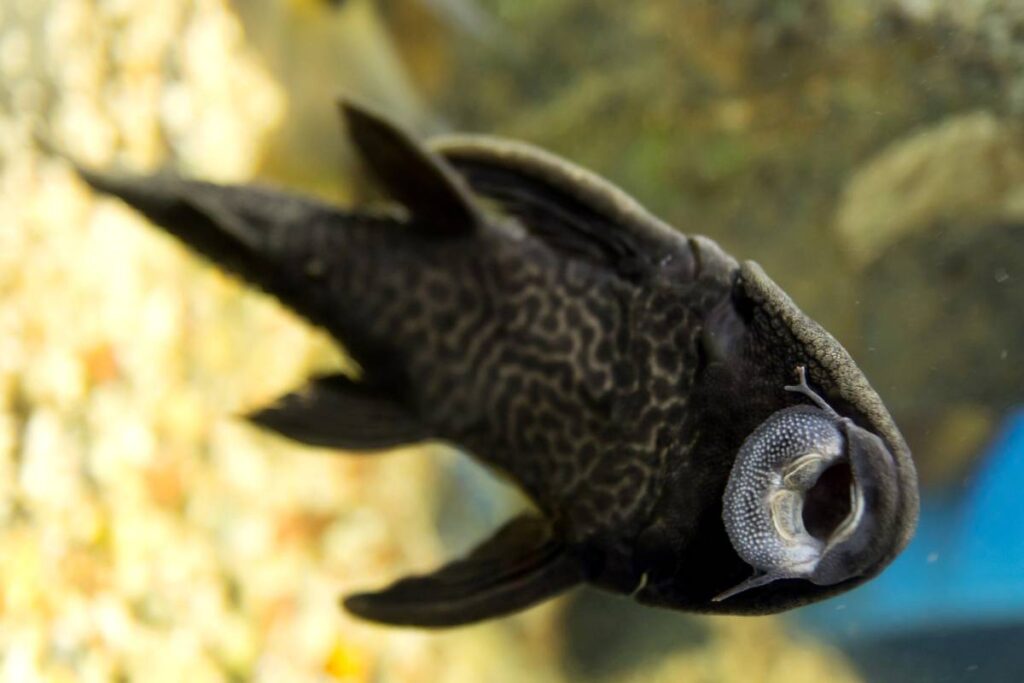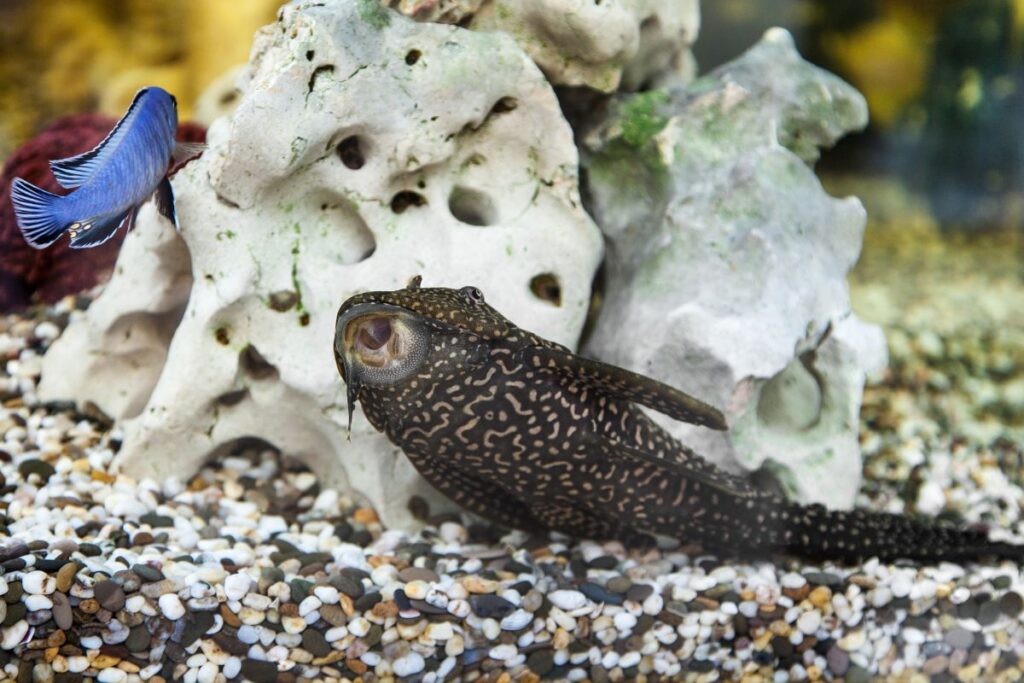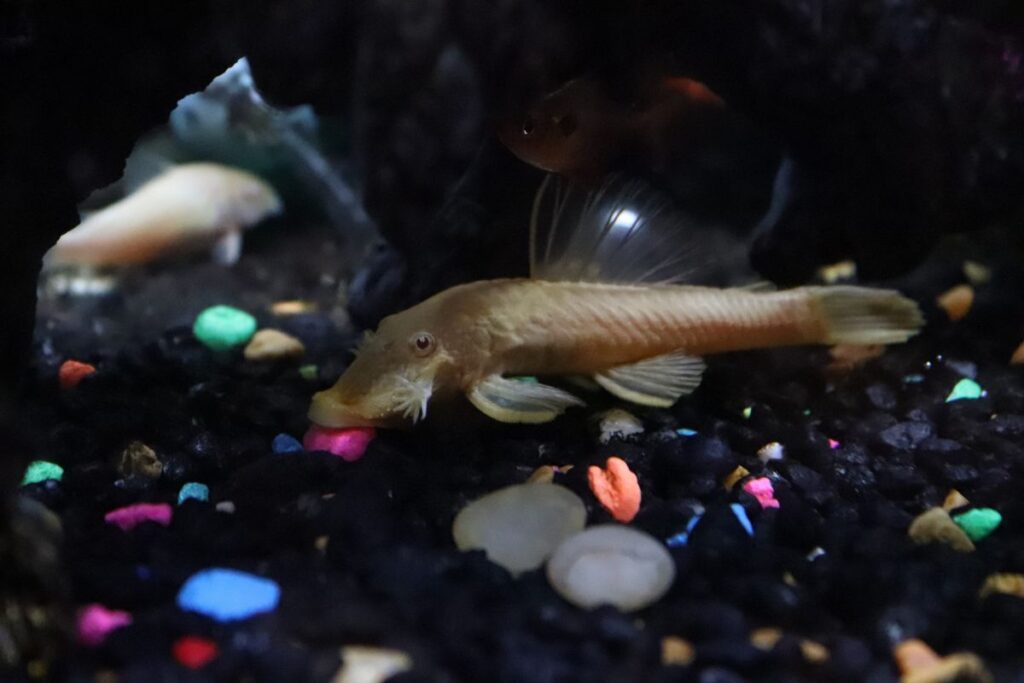If you’re a fish owner, you may have noticed your pleco upside down and wondered why. It’s a common concern among fish owners, and it can be alarming to see your fish in distress. As a fish owner myself, I have experienced this and understand how concerning it can be. In this article, we’ll explore the reasons why your pleco may be upside down and what you can do to help.
If a pleco is upside down, it may be a sign of stress, illness, or poor water quality. Other possible causes include swim bladder disorder, which affects the fish’s ability to regulate its buoyancy, or a lack of oxygen in the water. It is important to identify and address the underlying issue to prevent further harm to the pleco.
In this article, we’ll dive deeper into the causes of swim bladder disorder, how to prevent it, and what to do if your pleco is already suffering from it.
We’ll also explore other potential reasons for your pleco’s upside-down behavior and provide tips on how to maintain a healthy environment for your fish. By the end of this article, you’ll have a better understanding of why your pleco may be upside down and how to help it recover.

Table of Contents
Common Reasons for Pleco Upside Down
As a fish owner, seeing your pleco upside down can be concerning. However, this behavior is not uncommon and can be caused by various reasons. In this section, we will explore some of the most common reasons why your pleco might be upside down.
Tank Water Quality Issues
One of the primary reasons for pleco upside down behavior is poor water quality in the tank. Plecos are bottom feeders and can be sensitive to high levels of ammonia, nitrites, and nitrates in the water. These chemicals can cause stress and illness, leading to upside down behavior.
To prevent this, ensure that the water in the tank is clean and well-filtered. Regular water changes and tank maintenance can help keep the water quality in check. It is also essential to avoid overfeeding your pleco, as uneaten food can contribute to poor water quality.
Swim Bladder Disease
Swim bladder disease is another common reason for pleco upside down behavior. This condition affects the swim bladder, which is responsible for regulating buoyancy in fish. When the swim bladder is damaged or infected, it can cause the fish to float or sink uncontrollably.
To prevent swim bladder disease, ensure that your pleco’s diet is well-balanced and that the water quality in the tank is optimal. If your pleco is already showing signs of swim bladder disease, you may need to adjust their diet or use medication to treat the condition.
Injury or Trauma
Another reason for pleco upside down behavior is injury or trauma. This can occur if your pleco gets caught in decorations or if they are attacked by other fish in the tank. Injuries can cause stress and pain, leading to unusual behavior such as upside down swimming.
If you suspect that your pleco has been injured, inspect their body for any signs of damage. You may need to remove them from the tank and provide medical treatment to prevent further complications.
Stress
Stress is another common reason for pleco upside down behavior. This can be caused by a variety of factors, including changes in the tank environment, overcrowding, or aggressive tank mates. When stressed, plecos may exhibit unusual behavior such as hiding or swimming upside down.
To prevent stress, ensure that your pleco has enough space in the tank and that the tank environment is stable. Avoid sudden changes in water temperature or pH, and ensure that your pleco has plenty of hiding places to feel safe and secure.
Constipation
Finally, constipation can also cause pleco upside down behavior. This occurs when the fish is unable to pass waste properly, leading to discomfort and unusual behavior. Constipation can be caused by overfeeding or a lack of fiber in the diet.
To prevent constipation, ensure that your pleco’s diet is well-balanced and that they are not overfed. You can also provide fiber-rich foods such as vegetables to help regulate their digestive system.
Overall, pleco upside down behavior can be caused by various reasons. By identifying the cause, you can take the necessary steps to prevent and treat this behavior, ensuring that your pleco stays healthy and happy.
Personally, I have experienced pleco upside down behavior in my own tank due to poor water quality. After adjusting my tank maintenance routine and ensuring that the water quality was optimal, my pleco’s behavior returned to normal. It is essential to monitor your pleco’s behavior regularly to catch any issues early and provide prompt treatment.
Less Common Reasons for Pleco Upside Down

Parasitic Infection
While parasites are a common cause of fish illnesses, they are not typically associated with plecos being upside down. However, in rare cases, certain parasites can cause neurological damage that results in an inability to maintain an upright position.
I once had a pleco that was swimming upside down and showing other signs of distress. After taking the fish to the vet, I discovered that it had a parasite that was attacking its nervous system. The vet prescribed medication to treat the parasite, and the pleco eventually made a full recovery.
Neurological Issues
There are a variety of neurological issues that can cause a pleco to swim upside down. These can include head trauma, tumors, and other brain abnormalities. It’s important to note that these issues are relatively rare, and most plecos that swim upside down do not have serious neurological problems.
If you suspect that your pleco has a neurological issue, it’s important to take it to a vet who specializes in fish care. They will be able to diagnose the issue and recommend a course of treatment if necessary.
Genetic Disorders
Some plecos are born with genetic disorders that can cause them to swim upside down. These disorders can be difficult to diagnose, as they often do not show up until the fish is several months old.
If you suspect that your pleco has a genetic disorder, it’s important to consult with a vet who specializes in fish care. They will be able to help you determine the best course of action.
Overall, while less common, there are a variety of reasons why a pleco may swim upside down. If you notice your pleco exhibiting this behavior, it’s important to take action quickly to determine the cause and provide appropriate treatment.
Treating the diseases
When it comes to treating diseases that may cause your pleco to be upside down, you need to be sure of the exact ailment before administering any medication. This is where a vet or an experienced aquarist can come in handy. Here are some of the common diseases and their treatments:
Swim bladder disease: This is one of the most common causes of upside-down plecos. It is caused by a bacterial infection or poor diet. The treatment for this disease is to feed your pleco with high-fiber foods such as peas, spinach, and zucchini. You can also add Epsom salts to the water to help with constipation.
Internal parasites: These can cause your pleco to be upside down. You can treat this by using medications such as praziquantel, metronidazole, or fenbendazole. Make sure to follow the instructions on the medication package and consult with a vet or an experienced aquarist before administering any medication.
Columnaris: This is a bacterial infection that can cause your pleco to be upside down. Treatment involves using antibiotics such as tetracycline or erythromycin. You can also add salt to the water to help with the healing process.
It is important to note that prevention is always better than cure. Maintaining good water quality and providing a balanced diet for your pleco can go a long way in preventing diseases. I once had a pleco that was upside down for days, and I was worried sick. After consulting with an experienced aquarist, I discovered that it was due to swim bladder disease. I treated it with peas and Epsom salts, and it got better within a few days. It is always important to seek advice from experts when dealing with sick fish.
Preventing Pleco Upside Down

Maintaining Tank Water Quality
One of the most important ways to prevent pleco upside down is to maintain the quality of the tank water. This means keeping the water clean and free of toxins. You can do this by regularly cleaning the tank and changing the water. It’s also important to test the water regularly to ensure that the pH, ammonia, and nitrate levels are within the appropriate range.
Providing Adequate Hiding Places
Plecos need a place to hide and feel safe. If they don’t have a place to hide, they may become stressed and more prone to upside down syndrome. You can provide hiding places by adding caves, rocks, and plants to the tank. This will not only provide shelter for your pleco but will also add to the aesthetics of your aquarium.
Feeding a Balanced Diet
Feeding your pleco a balanced diet is also important in preventing upside down syndrome. Plecos are known to be herbivores, so it’s important to provide them with a diet that includes a variety of vegetables, such as zucchini, cucumber, and spinach. You can also provide them with algae wafers and pellets specifically designed for plecos. Avoid overfeeding your pleco as this can lead to health issues and ultimately, upside down syndrome.
Personally, I had a pleco that suffered from upside down syndrome, and it was a heartbreaking experience. I learned that prevention is key, and by following these simple steps, you can keep your pleco healthy and happy.
Is my pleco dead?
One of the most alarming sights for any fish owner is to see their beloved pet lying motionless at the bottom of the tank. If you find your pleco upside down and not moving, your first instinct might be to assume the worst. However, before you jump to conclusions, there are a few things you should consider.
Firstly, it’s important to note that plecos are known to play dead when they feel threatened. This is a natural defense mechanism that helps them avoid predators in the wild. If you notice your pleco lying motionless at the bottom of the tank, try gently prodding it with a net or your finger. If it suddenly springs to life and swims away, then it was probably just playing dead.
On the other hand, if your pleco is truly dead, there are a few signs you can look for. A dead pleco will typically have cloudy eyes, a pale color, and a lack of response to stimuli. Additionally, if your pleco has been dead for a while, it may start to decompose and release a foul odor.
It’s worth noting that plecos are known for their hardy nature and can often survive in less-than-ideal conditions. However, if your pleco has been displaying unusual behavior or symptoms, it’s always a good idea to consult with a veterinarian or an experienced fish keeper.
Personally, I once thought my pleco was dead when I found it lying motionless at the bottom of the tank. I was devastated, but decided to give it a gentle prod with a net just in case. To my surprise, it suddenly sprang to life and swam away as if nothing had happened. From that day on, I learned to never assume the worst when it comes to my fish.
Recommended products as per the article:
- API Aquarium Test Kit – This kit will help you test the water quality in your tank and ensure that the pH, ammonia, and nitrate levels are within the appropriate range.
- Hikari Algae Wafers – These wafers are specifically designed for plecos and will provide them with a balanced diet.
- Epsom Salt – Adding Epsom salt to the water can help with constipation, which is a common cause of upside-down plecos.
- Aquarium Caves – Providing your pleco with hiding places is important in preventing stress and upside-down syndrome. These caves are a great option.
- Tetracycline Antibiotics – If your pleco is suffering from columnaris, this antibiotic can help treat the bacterial infection.
Conclusion
After conducting thorough research and analysis, it is clear that an upside-down pleco is not a healthy sign. It is a symptom of a serious health issue that requires immediate attention.
If you notice your pleco upside down, it is important to act quickly and take the necessary steps to remedy the situation. This may include adjusting the water parameters, providing a balanced diet, and ensuring proper tank conditions.
It is also important to note that prevention is key in maintaining the health of your pleco. Regular water changes, proper filtration, and a balanced diet can go a long way in preventing health issues from arising in the first place.
As a personal anecdote, I once had a pleco that started exhibiting signs of upside-down behavior. I quickly took action and consulted with a veterinarian who was able to diagnose and treat the issue. Thanks to prompt action, my pleco made a full recovery and lived a long and healthy life.
Remember, the health of your pleco is in your hands. By staying vigilant and taking the necessary steps to maintain a healthy environment, you can ensure that your pleco thrives for years to come.
“Learn how to keep your pleco healthy and happy with our Pleco Care 101 guide – the ultimate resource for all pleco owners!”
Reference: Wikipedia.
